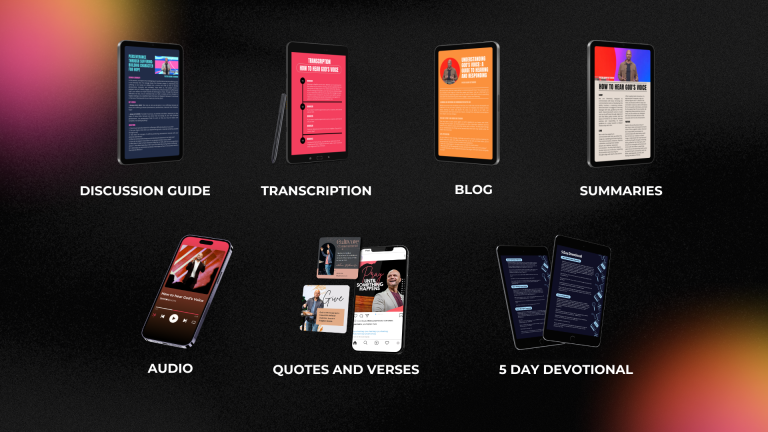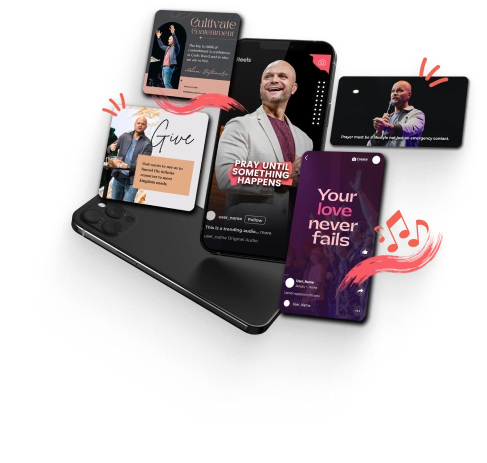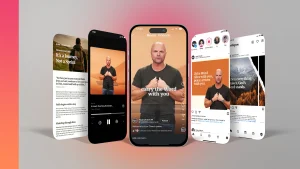Now can you transform a powerful sermon into real growth for your church community? It’s not just about stirring words and heartfelt delivery; it’s about making a lasting impact. Effective sermons can ignite change, drive engagement, and boost spiritual growth, but only if you know how to harness them. By using tools like sermon shots, you can extend the reach and influence of your message beyond the pulpit. This post will guide you through the steps to make your sermons resonate even more, turning passionate preaching into tangible outcomes. Ready to see your community thrive? Let’s get started.
Understanding the Components of a Powerful Sermon
Crafting a powerful sermon goes beyond just delivering words from the pulpit. It involves a blend of storytelling, teaching, and connecting that compels the congregation to both reflect and act. A powerful sermon can transform a listener’s heart, making it a critical tool for spiritual growth. Let’s break down the essential components that breathe life into your message.
Scriptural Foundation
Every powerful sermon is firmly anchored in the Bible. Why is this so important? It’s because the scripture acts as the backbone of your message, providing authority and direction.
-
Guidance: A strong biblical basis ensures your sermon aligns with God’s word, offering clear guidance to your audience.
-
Relevance: By focusing on scriptural teachings, you make your message more relatable and impactful.
-
Authority: Listeners are more likely to trust and follow a sermon that echoes biblical truths.
Without a solid scriptural foundation, a sermon can quickly lose its purpose and power, wandering away from the truths that people seek to hear.
Engaging Delivery
Your delivery style can make or break your sermon. It’s not just about what you say, but how you say it. To capture and keep the congregation’s attention, consider the following techniques:
-
Storytelling: Weave in stories, both biblical and modern, to illustrate your points. This makes the message memorable.
-
Voice Modulation: Vary your tone and pace to emphasize key points and maintain interest.
-
Body Language: Use gestures and eye contact to engage with your audience, creating a connection that sustains their focus.
Think of your sermon as a conversation, not a lecture. By speaking directly to your audience, you invite them into the message, encouraging a deeper engagement.
Real-Life Application
A sermon is most effective when listeners can see how it applies to their everyday lives. This might be the most essential step in turning a powerful sermon into spiritual growth. Consider:
-
Relatability: Share personal stories or current events that your congregation can relate to.
-
Actionable Steps: Offer clear, practical advice that listeners can apply during their week.
-
Encouragement: Motivate your audience to reflect and act on what they’ve learned, nurturing ongoing growth.
Does your sermon inspire change beyond Sunday morning? Ensuring it touches day-to-day experiences is key to fostering the transformation you aim for.
By focusing on these components, you can craft a sermon that not only speaks to the heart but also encourages growth and change within your congregation. Balancing scriptural truths with engaging delivery and real-life relevance turns your sermon into a powerful tool for spiritual impact.
Integrating Media Tools to Enhance Your Sermon
In today’s digital age, turning a powerful sermon into a growth opportunity for your congregation involves embracing technology. This means integrating various media tools to extend your message far beyond the walls of the church. Whether it’s visual aids, social media, or podcasts, these tools can amplify your sermon’s reach and impact.
Visual Aids
Imagine delivering a sermon without any visuals. Seems a bit flat, doesn’t it? Inserting slideshows and videos can bring your messages to life. Visual aids act like a magnifying glass, helping your audience focus more clearly on your key points.
-
Slideshow Presentations: Highlight essential verses or quotes. Use images that resonate with the theme of your sermon.
-
Videos: Share a brief clip that complements your sermon’s message. This could be a person’s testimony or a relevant scene from a movie.
With the right visuals, you’re not just talking to your audience; you’re inviting them to see and feel your message.
Social Media Promotion
Social media is like a megaphone for your sermon, enabling you to reach thousands with just a few clicks. Platforms like Facebook, Instagram, and Twitter can extend your message to audiences who might never step foot in your church.
-
Create Teasers: Share short video clips or inspiring quotes from your sermons to generate interest.
-
Engage with the Audience: Respond to comments or conduct live Q&A sessions. This turns a one-way sermon into a two-way conversation.
-
Share Events: Promote upcoming sermons or related events to keep your audience engaged and looking forward to your next message.
Why let your sermon sound off only inside four walls when social media can let it echo far beyond?
Podcasting Your Sermons
Podcasting is like having a portable sermon—perfect for commuting, working out, or any moment in between. Let’s face it: life gets hectic, and not everyone can catch a sermon live or in person. Sharing your sermons through podcasts can be a tremendous boon to your growth efforts.
-
Ease of Access: Your congregation can listen anytime, anywhere.
-
Building a Connection: Regular podcasts can help people feel more connected to your church, especially those who miss services.
-
Wider Reach: Anyone with an internet connection can find and listen to your sermons, introducing your voice to potential newcomers.
Podcasting is not just a method of sharing; it’s a bridge connecting your message with more hearts and minds.
By making use of these media tools, you can truly transform your powerful sermon into a dynamic force for growth and connection. Each tool has the potential to turn a moment of inspiration into something lasting, profound, and widespread.
Creating a Follow-Up Plan for Sermon Growth
A powerful sermon can be the seed for growth in both faith and community. However, without a plan to nurture it, the message might end up like a fleeting memory. Let’s dive into making sure your sermon has a lasting impact.
Small Group Discussions
Encouraging small group discussions can be like planting a garden where ideas blossom. After your powerful sermon, invite participants to break into small groups. Here, they can reflect and share personal insights. This isn’t just about talking, it’s about connecting. Think of it as having a chat over coffee, but the caffeine is the lively exchange of ideas.
By having these discussions:
-
People Feel Heard: Everyone gets a chance to speak and share their thoughts.
-
Builds Community: It strengthens bonds as members learn from each other.
-
Deepens Understanding: Taking time to discuss can lead to aha moments they might not have had alone.
Feedback Mechanisms
To keep your sermons impactful, feedback is your best friend. Implementing ways to gather feedback from your congregation can help you understand what resonates and what’s not quite hitting the mark. It’s a bit like having a GPS for your preaching journey.
Ways to gather feedback:
-
Surveys: Hand out short surveys after the service.
-
Online Forms: Use digital forms for those who prefer online interaction.
-
Comment Cards: Set up a feedback box where people can drop comments.
With this information, you can tailor your messages to better fit the needs and questions of your audience.
Connecting with New Visitors
Picture this: Each new visitor is like a potential new friend. Engaging with them after your sermon ensures they feel welcomed and valued, not like a stranger. Growth isn’t just about retaining the faithful, but also about embracing newcomers.
Strategies to connect:
-
Welcome Teams: Have friendly teams ready to greet and chat after the service.
-
Follow-Up Emails: Send a quick thank-you email with a note about upcoming events.
-
Visitor Cards: Encourage newcomers to fill out a card with their contact details so you can stay in touch.
These small gestures can transform a visit into a meaningful connection, nurturing a community where everyone feels at home.
Measuring the Impact of Your Sermon
How do you know if your powerful sermon is making a difference? Measuring its impact might seem like trying to catch the wind, but it’s not as tricky as it sounds. By focusing on clear strategies, you can see if your words are truly resonating with your audience and fostering growth within your congregation. Here are some key methods to measure the impact of your sermons.
Attendance Tracking
One of the simplest ways to gauge your sermon’s effectiveness is by watching attendance trends. Is your congregation growing, or do you see more empty seats than before?
-
Record Weekly Attendance: Keep a consistent record of how many people attend.
-
Look for Patterns: Notice if certain topics or sermon series attract more people.
-
Don’t Ignore Drop-offs: A sudden decline might signal a disengagement or a need to revitalize your approach.
Knowing who is showing up can be like taking your sermon’s pulse. It gives a real sense of whether your words draw people in and encourage them to return.
Engagement Surveys
Another way to measure impact is by using engagement surveys. These can help you understand how involved and interested your congregation is with your sermons.
-
Create Simple Surveys: Use questions that are easy to answer, focusing on sermon content and delivery.
-
Invite Anonymous Feedback: People are likelier to be honest if they don’t have to attach their names.
-
Ask for Specifics: Questions like “What part of the sermon spoke to you?” or “Did you feel inspired to take action?” can give you direct insights.
These surveys are like a flashlight in the dark, shining a light on what resonates with your audience and what doesn’t.
Spiritual Growth Assessments
Finally, to see if the spiritual development of your congregants is a result of your powerful sermon, consider implementing spiritual growth assessments.
-
Conduct Regular Check-ins: Periodically ask congregants to reflect on their spiritual journey.
-
Use Self-Assessment Tools: Encourage them to rate their own growth and understanding of their faith.
-
Collect Stories and Testimonials: Personal stories of growth can be a testament to the influence of your sermons.
By evaluating spiritual growth, you get more than just numbers. You learn whether your teachings are guiding your congregation closer to their spiritual goals, like watching seeds sprout in a garden.
Armed with these tools, tracking the impact of your powerful sermon becomes a journey of discovery, providing the insight needed to craft messages that inspire and uplift.
Improve your Sermons Impact and Reach
Turning a powerful sermon into growth requires action and intention. By integrating practices that expand your message beyond the pulpit, churches can engage more deeply with their community. Incorporating tools like sermon shots can amplify your reach and impact, driving change and strengthening your congregation’s bonds.
Now is the time to embrace these strategies and watch your efforts transform into meaningful growth. What steps will you take to ensure your message influences lives beyond Sunday? Keep the conversation going, and let’s continue building a stronger foundation for faith and community together.
Thank you for investing your time in exploring these insights. Your commitment enriches not only your journey but also the lives of those you lead.





